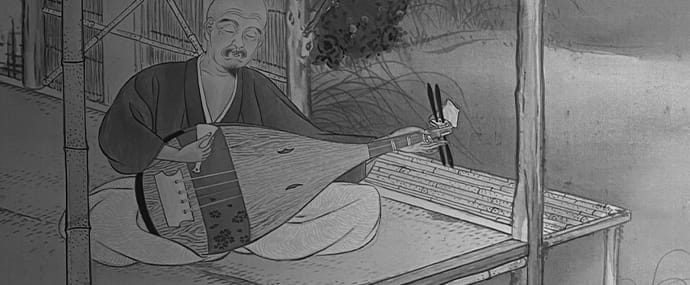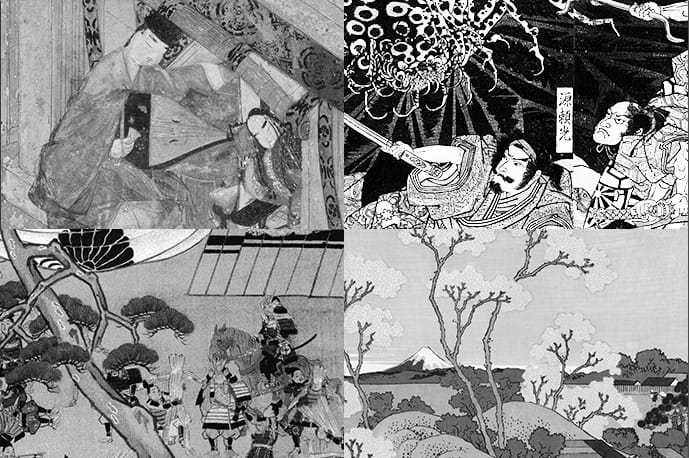1. Early History
The Oxford Dictionary of Music and Grove Music Online contain comprehensive articles on the history of biwa, and thus only a small survey is presented here.
Organologically, the biwa is a lute that originated in Mesopotamia. While most ancient lutes used animal skins to cover the resonating body - as is still the case today for the other important Japanese lute, the shamisen - this string instrument gradually came to be entirely made of wood, perhaps during the centuries of cultural exchange on the Silk Road. In Arabic, “wood” is “ud,” and the English word “lute” thus developed from “the wooden one,” or “el ud.” The most important historical references for the instrument, which reached the Far East in the first half of the 1st millennium, are pictorial representations of lutes most likely made entirely of wood as can be seen in silver bowls from the Sassanid period (224-651).
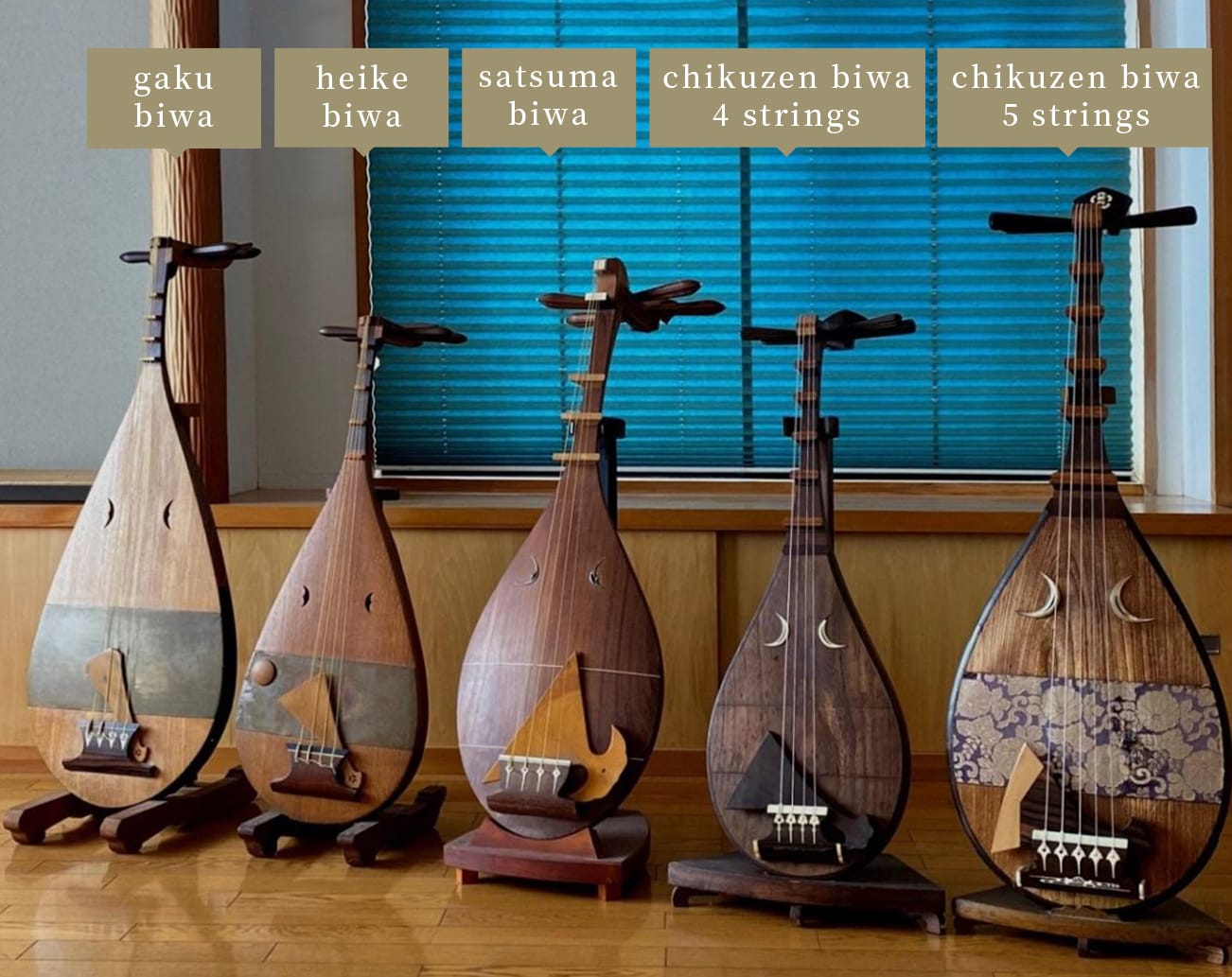
(Instruments from the Guignard Collection)

In Persian, the instrument was called barbat, or “duck's breast,” this word possibly influencing the nomenclature in Asia. The instrument reached China during the Tang dynasty (618-907) where it became an extremely important instrument in musical culture. In China, it was given the new name pipa, which possibly derived from barbat. There is, however, another interpretation based on playing technique, ‘pipa' being the Chinese onomatopoetic realization of the two most important strokes of the plectrum: pi, or “up”, and pa, or ‘down.'
During the 7th and 8th centuries, when Japan began importing Korean and Chinese culture, the Chinese name of the instrument was adopted by the Japanese, but pronounced in Japanese as biwa. The pipa/biwa presumably came to Japan as one of the instruments of a Chinese court orchestral ensemble, known in Japanese as gagaku.

Several biwa from Tang-dynasty China have been preserved in the Shōsōin, an Imperial Treasure House located in Nara since the late 8th century. Some are lavishly decorated with inlay of mother-of-pearl and semi-precious stones, while others have a plectrum guard with Chinese paintings reflecting various Silk Road cultures. With the exception of one instrument, all biwa preserved from this period have four strings. The four-stringed biwa was unquestionably the standard as ironically attested to by a decorative detail on the sole 5-string instrument, a gorgeously decorated biwa assumed to have been brought from India and presented as a gift to Emperor Shōmu (701-756). The plectrum guard depicts a biwa player sitting on a camel; however, he is not performing a five-stringed instrument, but a four-stringed one, presumably as this was the norm.
Outside of minor details, the biwa used in today's gagaku orchestra, the gaku biwa, is identical with the instruments in the Imperial Treasure House in Nara. Its main musical function in the ensemble is to emphasize the strongest beat of the main melody, which can be transnotated in 4/4, with an arpeggio. The gaku biwa also had a solo repertoire, only three (four) pieces of which have been transmitted as the “Three Secret Pieces” (sanhikyoku) in handwritten copies. These works, however, are no longer included as part of the court musicians' repertoire. (The author recorded all four solo gaku biwa pieces [based on an early 17th century handwritten copy] in Basel, Switzerland for Radio DRS 2, on 20th of October 2009.)
Outside of the courtly instrumental solo-biwa music, there was also a form of Buddhist chanting to the accompaniment of the biwa performed by primarily blind priests. Sources from the 10th century suggest that these biwa-priests also engaged in story-telling and song-performing. A narrative genre known as heike biwa developed from these traditions. In 1185, the court culture of the Heian period (794-1185) came to an end with the Battle of Dannoura. This battle was the last of the many tragic events sung in the Tale of the Heike, or Heike monogatari (abbr. HM). One of the earliest versions of this work was written or edited by the blind biwa player, AKASHI Kakuichi (1279-1371). The Kakuichi edition became the standard version and represents the synthesis of the many bardic traditions that existed at the end of 12th century, these traditions consisting of recited battle-reports and of stories mourning the death of heroes that were considered a form of chinkon, or the pacification of unredeemed souls. The biwa used in heike recitation is a smaller form of the gaku biwa. As a musical genre, however, heike biwa is a seminal moment in Japanese music history. Kakuichi's standardization of the various traditions deeply influenced and served as the basis for all later biwa styles as well as new narrative genres that appear much later, such as gidayū-bushi, which is associated with the bunraku puppet theater tradition.
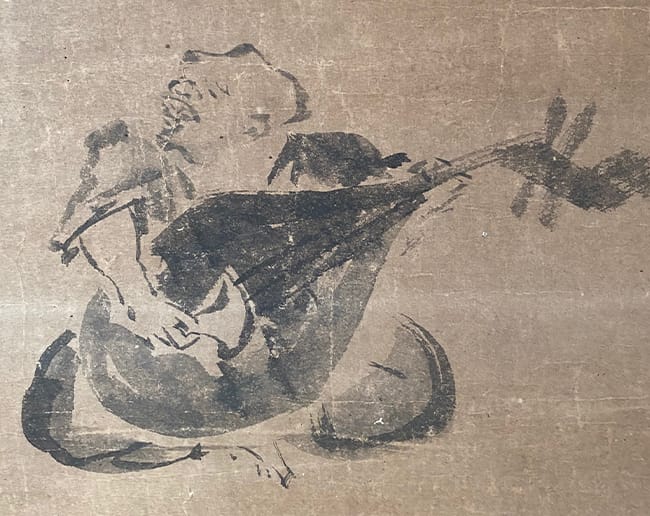
While the chanting of (non-canonized) sutra to the accompaniment of the biwa was musically less sophisticated than the heike biwa tradition, it nonetheless played crucial role in the development of the instrument's culture. On the main island Honshu, the biwa-performing Buddhist priests were known as biwa hōshi, or “biwa priests”, even though many were not properly trained Buddhist priests. At the beginning of the Edo-Period (1603-1867), they were integrated into the Tōdōza, a powerful organization that exercised complete control over their activities, while nevertheless providing these socially low performers with a certain dignity and financially stability.
The blind biwa-priests of Kyushu, however, refused to enter this organization and referred to their instrument as mōsō biwa, or “blind priest” biwa. Kyushu, especially Satsuma (present-day Kagoshima Prefecture) in the South, contributed greatly to the development of the modern biwa. For centuries, and well into the 19th century, access to Satsuma was difficult and travel to the region challenging. A distinct culture arose, and even the language came to differ considerably from other regional dialects in Japan. The biwa also developed into a completely new genre in Satsuma: the chanting of sutras to the accompaniment of biwa was less than remunerative, and the biwa-priests thus also performed secular songs. As they were not members of the Tōdōza, they were forbidden from using the shamisen for these secular works. They therefore began accompanying themselves on a modified form of the heike biwa in the late 17th century. This tradition then evolved into modern satsuma biwa.
The neck of the satsuma biwa has four high frets, and most pitches are thus produced by pressing the strings between the frets. For high pitches his requires a surprising amount of strength on the part of the performer. The exertion of force is seen as a samurai virtue as is the endurance of pain. The large fan-shaped plectrum is held in such a fashion that most beginners find it uncomfortable. Needless to say, only men played the satsuma biwa.
It was not until the beginning of the Meiji period (1868-1912), when Satsuma started to open up to the rest of Japan, that the instrument came to be known beyond the narrow territorial boundaries. Knowledge of satsuma biwa music culture, one important musical characteristic being a highly developed approach towards instrumental improvisation, can only be traced back to the 19th century.
In this period, when the Satsuma Domain opened, many politicians in the new Tokyo government came from this formerly isolated area of Japan. The satsuma biwa came to occupy a surprisingly important position in the arts, and became something of a cult. The virile aspects of satsuma biwa playing came to be particularly emphasized with the nationalism that began during this period. Tradition holds that there were soldiers who went to battle with an instrument over their shoulders. (See the ballad Saigō Takamori lines 45-50) The satsuma biwa was therefore taken to Tokyo by the politicians from Kagoshima. Here, from the new center of the nation, the instrument and its music spread quickly and gave birth to many new satsuma biwa styles, the most important of which to this day is the Kinshin school.


2. History of the Chikuzen Biwa

When satsuma biwa began to gain popularity across the country, a similar movement emerged in northern Kyushu with the aim of creating a new genre from the centuries-old biwa priest tradition. Like Satsuma, there was no standardized instrument in northern Kyushu. One instrument that should be mentioned is the sasabiwa, a bamboo-leaf shaped biwa that, under the influence of the shamisen, was slim, light, and portable (see picture left). It was mainly used by the priests on dankamawari, long seasonal journeys into the countryside where they visited Buddhist parishioners to perform hearth-purification rituals (kōjinbarai) to the accompaniment of the biwa in farmhouse kitchens.

After these religious ceremonies, the biwa priests (mōsō) also performed songs for entertainment. With the far-reaching social changes at the end of the Edo-period‐the privileges of the mōsō, for example, were abolished in 1871 - much of this secular repertoire was lost. In 1987, this author visited the 91 year old biwa player, YOSHITSUKA Genzaburō in Fukuoka who in his youth had given numerous unusual and entertaining performances (see picture right). He played the biwa above his head (kyokubiki, which is an old Chinese tradition) and sang sections of a text that was little more than thinly veiled erotica. The late satsuma biwa player, FUMON Yoshinori, in Tokyo recounted similar stories about the decline of the biwa priests to this author.
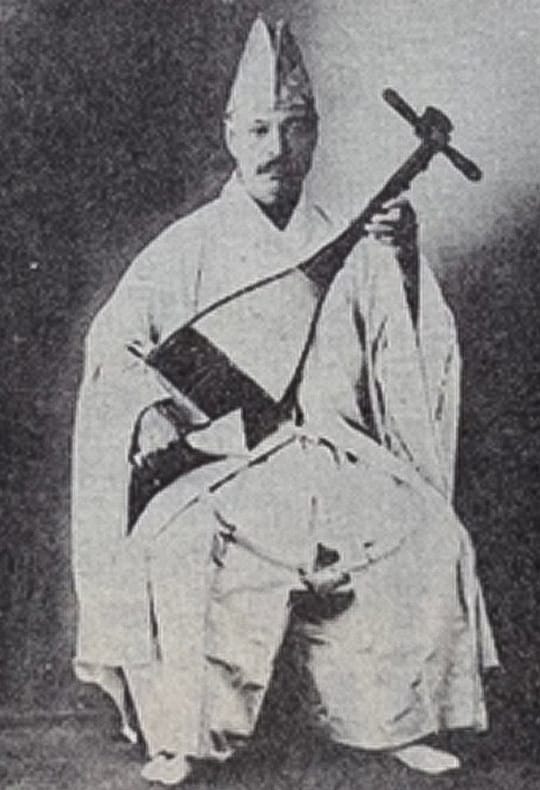
This period crisis for the biwa priests' entertainment culture was when the TACHIBANA - a well-known biwa family that according to a late 18th century source, traced its ancestry to the "first" biwa priest Gensei Hōin (765-823) - conceived of standardizing the instrument and creating a new narrative genre that later came to be called chikuzen biwa. The intention was to create a counterpart to satsuma biwa by this genre from Chikuzen, a region that corresponds to today's Fukuoka Prefecture in northern Kyushu.
TACHIBANA Chitei (1848-1919), a descendant of priest Gensei Hōin, was the leading figure of a small group of musicians that included TSURUZAKI Kenjō, another descendant of a biwa priest family in Fukuoka, and YOSHIDA Takeko, a shamisen performer from the entertainment district in Fukuoka who studied under TACHIBANA Chitei. (She later left the group and taught and performed biwa in Tokyo.) The presence of a female shamisen player in these circles is significant as up to this point, biwa performers, regardless of genre, had always been men. (This restriction is odd given that Benzaiten, the deity of music in Japan and commonly depicted performing the biwa, is female.)
The tuning and some of the chikuzen biwa performance techniques are clearly derived from shamisen playing, and indeed, the first chikuzen biwa plectrum was modeled after the shamisen plectrum. Although TACHIBANA Chitei was also a skilled shamisen-player it may be possible that an aesthetic component of the new genre can be traced back to YOSHIDA Takeko: chikuzen biwa has always been seen as an elegant, feminine counterpart to the manly, resolute satsuma biwa.
TACHIBANA Chitei based his style on the satsuma biwa by doing field-work in Kagoshima, as the instrument had long since diverged from the priests' biwa music and acquired its own artistic features. In some chikuzen biwa interludes, the influence of the satsuma biwa improvisational models remains clear.
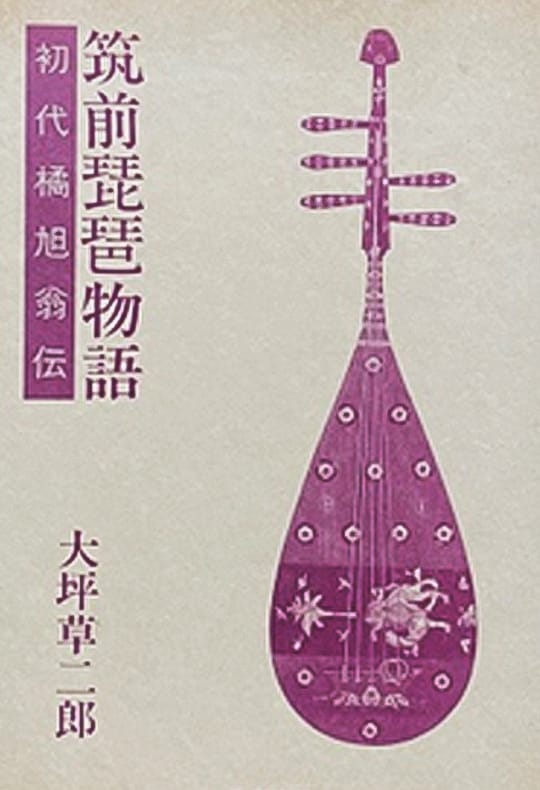
In 1896, TACHIBANA Chitei first performed in Tokyo under the name of Kyokuō, but was later came to be known as TACHIBANA Kyokuō I. Soon after this performance, he established his own biwa society, which he called "Tachibanaryū" or Tachibana School. Even today, all members of this society receive an artistic name (gagō) that indicates their affiliation with the school, the first character invariably being kyoku 旭 “rising sun” or “morning sun”. The family name is followed with the artistic name and is always used when performing.
The original chikuzen biwa, now rarely played, had 4 strings, the biwa-norm for centuries. The modest size of the original 4-stringed chikuzen biwa was assuredly based on the instruments associated with the biwa priests in Northern Kyushu. Kyokuō I, however, soon experimented with improving the instrument and created a 5-stringed biwa tuned to e, B, e, f#, and b, which is a combination of the 4-stringed chikuzen biwa tuning (B, e, b, b) and the satsuma biwa tuning (e, B, e, f#,). He patented the new design in 1910. This invention not only enabled him to enrich his instrumental style, but also increased the stature of his new art. He doubtlessly hoped to create a 5-stringed chikuzen biwa that matched in prestige the 5-stringed biwa of the Imperial Treasure House in Nara. This may explain the depiction of the legendary 5-stringed biwa from the Imperial Treasure House (see inset) on the cover of his biography by ŌTSUBO Jirō, Chikuzen biwa monogatari 筑前琵琶物語(1983).
Kyokuō I and his second son, Kyokusō I, also a performer, experimented in designing the 5-stringed chikuzen biwa, the standard instrument today. Artistically compatible with his father, it was the second son, rather than the first son, also a performer, who accompanied Kyokuō I on tour. Kyokuō I died in 1919, and at this time, it would have been customary for the eldest son to assume leadership of the Tachibana School. The elder son, however, was focused on modernizing the biwa. For example, he reformed the instrumental notation modelling his changes on Western staff notation. His younger brother, however, was a traditionalist with high artistic standards. The second son's intellectual and musical rigor led the father to favor the second son. Late in life, he made clear that his second son was to be allowed to establish his own association in which the artistic legacy of the father would be faithfully transmitted and thus on equal footing. The older son thus assumed official leadership of the Asahikai (or Asahi Association), took the name TACHIBANA Kyokuō II, and become the iemoto or head of the association. The younger brother took the name TACHIBANA Kyokusō I (1892-1971) and became the iemoto of the Tachibanakai (or Tachibana Association).
The Asahikai and the Tachibanakai remain the two most important associations of chikuzen biwa today. In the early 20th century, however, when the biwa was extremely fashionable, numerous other schools and associations, which cannot be discussed here, appeared.

TACHIBANA Kyokusō I initially worked primarily in Tokyo - it was only from here that the biwa could spread nationally. In 1923, however, the great earthquake occurred, and forced TACHIBANA Kyokusō I to temporarily relocate to Osaka where he managed his association and taught the biwa. For 17-year old YAMAZAKI Kyokusui (1906-2006), who lived in Osaka, this was a unique opportunity to be taught directly by the head of the association (iemoto). As a rule, TACHIBANA Kyokusō I only taught members who had at least a “teacher's rank” (kyōju), but YAMAZAKI Kyokusui's rank was at that time shōgō - four ranks below kyōju. This raises the question as to how she came to receive lessons from him directly. The reason for this exemption was that TACHIBANA Kyokusō I immediately recognized her outstanding technical and vocal skills, and thus had high expectations for her future as a biwa performer. YAMAZAKI Kyokusui remembered painful lessons in which physical attacks with the plectrum were not uncommon. His rigorous training, however, brought results. In later years, Kyokusō I composed Ibaraki for YAMAZAKI Kyokusui, a highly demanding work in which he fully exploited the specific qualities of her voice. Adhering to the ideals inherited from his father Kyokuō I, his instruction was extremely demanding as he imparted the art of chikuzen biwa. A devoted student, she continued his legacy to the best of her ability. Most regrettably, the artistic demands he placed on himself were so high that he never allowed recordings of his playing and singing, and the members of the Tachibanakai have no concrete idea of the actual sound of TACHIBANA Kyokusō I's performances.
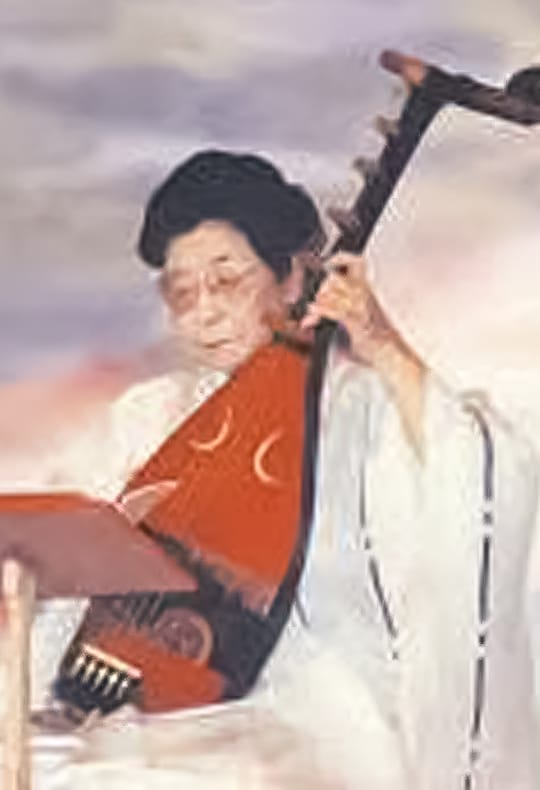
YAMAZAKI Kyokusui's pursuit of authentic performances of Kyokusō I's musical style is reflected in the great emphasis she put on the notation of the pieces. The Tachibanakai scores differ in their exactness, accuracy and sophistication from the Asahikai scores in which many details are left to the performer. In the Tachibanakai there is, as it were, an “Urtext”, and unconditional loyalty to this “Urtetxt” assuredly accounts for the two “Living National Treasures” this school has produced. In the traditional Japanese arts, despite the vital importance of oral transmission, only clearly and unambiguously notated scores may guarantee that the art does not go astray. This then gains depth in the practice of the players and singers over generations.
3. Present Situation of the Chikuzen Biwa in the Tachibana Association (Tachibanakai)
The head of the association (iemoto) TACHIBANA Kyokusō II, the son of Kyokusō I, is still the main authority of the association, but the official functions at this point have been assumed by his daughter, TACHIBANA Kyokutei, the jiki iemoto or designated head-successor of the association. Neither TACHIBANA Kyokusō II nor his daughter are professional biwa players. Kyokusō II therefore relied entirely on YAMAZAKI Kyokusui for musical judgement and authorized her to use the title of sōhan, “General Master”. The sōhan title has been vacant since her death, but today, Ms. YAMAZAKI's most recognized student, Ms. OKUMURA Kyokusui in Osaka, now a "Living National Treasure", has assumed artistic leadership of the Tachibanakai. OKUMURA studied the entire repertoire under YAMAZAKI and is the sole artist capable of transmitting these works and the art of the Tachibanakai biwa.
As of December 2020, the Tachibanakai had 258 members nationwide, most living in the Kansai and Kantō region as well as in Kyushu, primarily Fukuoka and Kagoshima. Ms. OKUMURA oversees the students in Osaka, Kyoto, Nara, Shiga and Hiroshima. Only a few members live in Tokyo, Nagoya and other places.
As is the custom in the traditional arts of Japan, the association has a pyramid ranking system. The top ranks of sōhan, previously held by YAMAZAKI Kyokusui, and sōshihan are now vacant. The next rank daishihan (“Grand Master”) is held by Mrs. OKUMURA Kyokusui and one other performer. Below this rank are five shūshihan performers (“Excellent Masters”), one of whom is the author of this publication. Below this rank there are several shihan, or “Masters.” Below the shihan rank, which is awarded after a player has acquired a certain level of proficiency, studied a respectable number of pieces and passed an exam, there are 10 further ranks that a student acquires at one to three year intervals, depending on talent, artistic skill, and dedication.
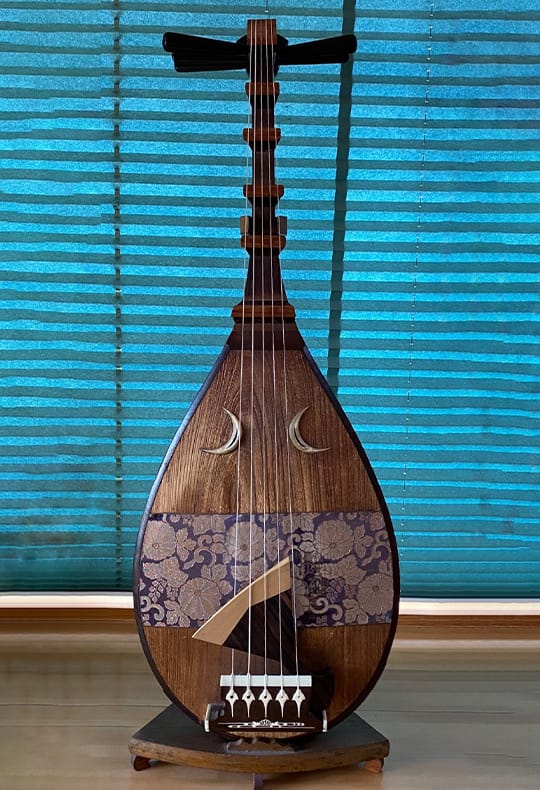
As in all Japanese traditional arts and disciplines, students have to pay a set sum upon receiving a certificate of a rank authorized by the iemoto. Further costs are the annual membership-fee, for which the members also receive a quarterly Newsletter. Then they pay a monthly lesson fee (gessha) to their teacher. Since there are no instrument shops that have biwa on display, biwa and plectrums are usually purchased from the teacher or from one of the few remaining biwa makers. Recently, the internet has changed the conditions for purchasing an instrument. The 15 books that contain the lyrics and musical settings for 5 to 7 ballads and the one volume with the scores for the various instrumental interludes, however, can only be purchased by Tachibanakai members. In principle, photocopies are prohibited. In this publication, it was therefore impossible to include complete originals of the ballads.
Traditional genres, such as chikuzen biwa, perceive themselves as educational disciplines, as a training that shapes body, mind, knowledge, and consciousness. The goal is therefore not to become a professional musician who lives from concert appearances, but instead, to become a teacher. Professionalism nonetheless happens, and while those performers that are professionals are admired for this, the basic concept of training and practice remains unchanged.
Members' concerts are presentations that can last for several hours, with more than 20 players appearing on stage to perform a 15 minute's excerpt from a piece. The performance order is determined by skill and rank: beginners play at the start, and as the concert progresses, are followed by increasingly skilled and higher ranked performers, the highest ranking master performing at the end.
The largest and most important presentation is the National Performance Event (Zenkoku Ensō Taikai), which is held in various cities in rotation throughout the country. As there are commonly many members who wish to participate, the program includes several group performances with some solo presentations to ensure that as many people as possible can participate, and that the event will end within one day. Performers pay for their performance and participation. Tickets are not sold and the concert is open to the general public.
The annual National Performance Event is always an opportunity for the Tachibanakai to present the members and display the results of their studies to the public. It is also a notable social event. In the past, the participants toured the local sights as a group the day after the concert. Recently, however, only a banquet is held after the concert as most players want to return home on that evening.
Before World War II, when Kyokusō I headed the Tachibanakai, there were approximately 8300 members, including those living overseas. This changed after the war. With the Japanese defeat in the war, the public's interest in tales of war faded, and the instrument and its music came to be seen as a pastime for the elderly. This image has improved over the last few decades. Today, chikuzen biwa is an “Important Intangible Cultural Property of Japan”, and young Japanese people interested in music and the traditional arts are no longer hesitant to opening themselves to this genre, despite the heavy emphasis on tales of battles and heroes. The rebirth of interest in Japanese culture and the traditional arts has given members of the Tachibanakai and the entire biwa community hope that the fascinating narrative arts of the biwa will survive into the future. The Tachibanakai is making every endeavor to ensure that the appeal and cultural validity of chikuzen biwa continues into the future as an invaluable aspect of Japanese culture that transcends national borders.
References
岸辺成雄他編(1981~1983)『音楽大事典』1~6巻、平凡社
平野健次、上参郷祐康、蒲生郷昭監修(1989)『日本音楽大事典』平凡社
国立劇場編、小島美子監修(2008)『日本の伝統芸能講座 音楽』淡交社
武蔵野音楽大学楽器博物館編(2003、2011改訂)「武蔵野音楽大学楽器博物館研究報告書 Ⅸ」
